7 Powerful Charts That Prove Renewable Energy is Not “Hippie Talk”
VW may just have unveiled a new electric version of its classic hippie van, but renewable energy is not “hippie talk” a senior diplomat has said.
Plunging costs driven by new technologies and policies have unleashed unprecedented growth in the renewable energy sector according to a new publication by the International Renewable Energy Agency (IRENA).
UN General Assembly president Peter Thomson spoke at the report’s launch and put it like this: “Ten years ago, renewable energy was considered hippie talk” but now it is “becoming a reality,” according to an IRENA tweet.
The REthinking Energy report highlights how global investment in renewables has now grown for more than a decade, from less than $50 billion in 2004 to a record $305 billion in 2015.
10 years ago, renewable energy was considered ‘hippie talk’. Now is becoming a reality—H.E Peter Thomson @UN_PGA #IRENA7A pic.twitter.com/BcWBIp25Py
— IRENA (@IRENA) January 15, 2017
Remarkable Growth
The report was released at the agency’s seventh annual assembly which took place this weekend (14 – 15 January 2017). Ministers and high-level representatives from over 150 countries discussed steps to accelerate the global energy transformation.
“Renewables are gaining ground by nearly every measure,” IRENA chief Adnan Z. Amin said. But despite the remarkable growth – led by the power sector – faster and broader growth is needed to meet the international carbon reduction targets the report stresses.
The renewable energy revolution should further increase its pace and expand beyond the energy sector into areas such as the heating and cooling in buildings and industry and into the transportation sector, the IRENA publication recommends.
1. Widening Gap
Since 2012, new generating capacity in the power sector fuelled by renewable energy has exceeded that of non-renewables – and the gap is widening. In 2015, renewables represented 61 per cent of all new power generation capacity added worldwide. Today, one out of every five units of energy delivered to consumers already comes from renewable sources, IRENA says.
Renewable and non-renewable power capacity additions, 2001-2015
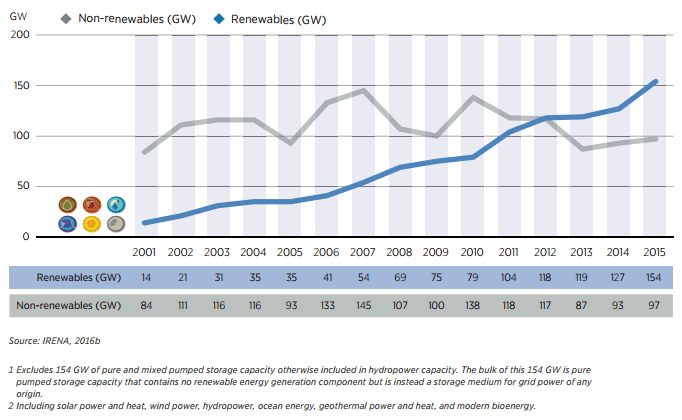
2. Plunging Prices
The prices of solar panels have plunged by 80 per cent since 2009, IRENA says, while pointing out that some other renewable technologies have already reached “grid parity.” Onshore wind, biomass, geothermal and hydropower are all already competitive or cheaper than coal, oil and gas-fired power stations, the report says – even without financial support and despite the low price of oil at the moment.
Evolution of utility-scale solar PV auction prices
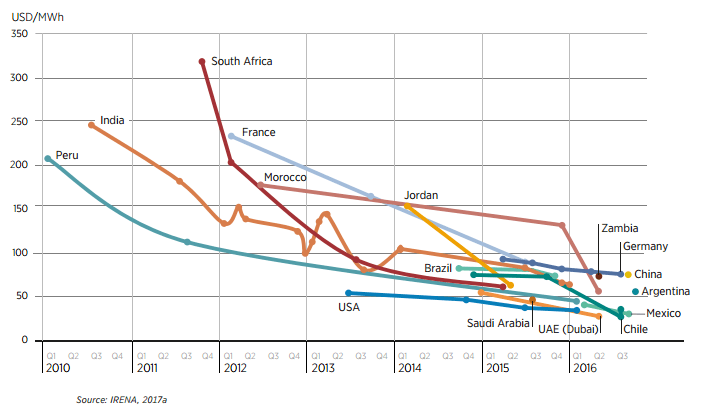
3. Job Growth
Renewable energy is already a key source of new employment, according to IRENA. It is estimated 9.4 million jobs were generated by the sector in 2015. Asia is the leading region, with solar and bioenergy as the leading technologies. If the share of renewables will reach 36 per cent by 2030, the total amount of jobs in the sector could surge to an estimated 24.4 million IRENA estimates.
Global employment in renewable energy, 2011-2015

4. Solar Race
Solar panels are now used in most countries around the world, according to IRENA. The technology has also brought electricity to millions of people who previously didn’t have access to energy. China, which is already leading the world in this chart, recently announced it will add the equivalent of 1000 major solar power plants to its solar capacity over the next five years.
Capacity by country, 2015
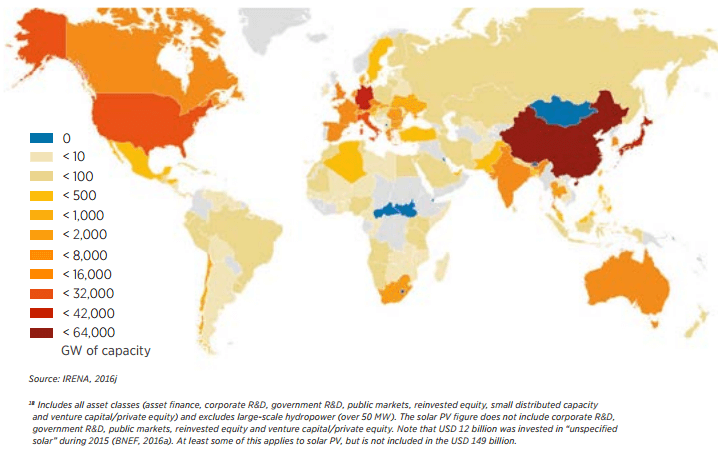
5. Battery Boom
Battery use is expected to increase substantially over the next few years, with the largest markets in North America, Europe and Asia-Pacific according to IRENA. The cost of battery storage systems is expected to fall due to rising demand in the electric vehicle sector, international competition and more manufacturing capacity. Tesla’s Gigafactory is expected to produce more lithium-ion batteries next year than were produced worldwide in 2013, for example.
Market value, top seven countries and rest of world, 2010, 2015 and 2020 (projected)
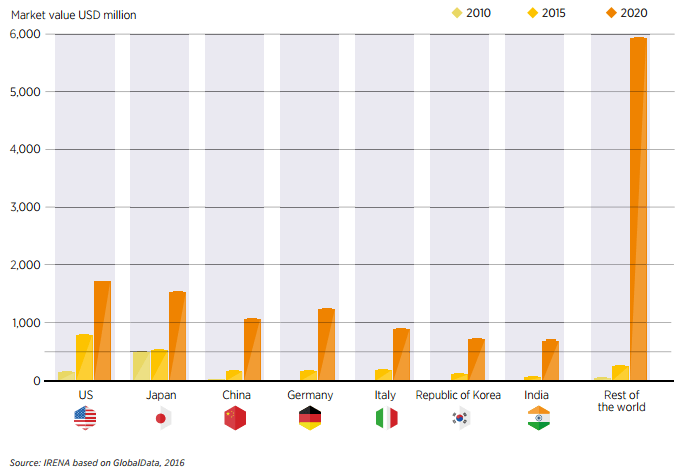
6. Global Investment
Investment growth in renewables primarily focused on solar and wind, according to IRENA. Both technologies saw investment increases by 13 per cent and 16 per cent over 2014. IRENA says that despite the new records set in 2015, total investment in renewable energy is still not enough to meet the international climate goals. An estimated average $770 billion will be needed annually in 2016-2030 to double the share of renewable energy in the global energy mix, IRENA says.
Investment by geography, 2004-2015
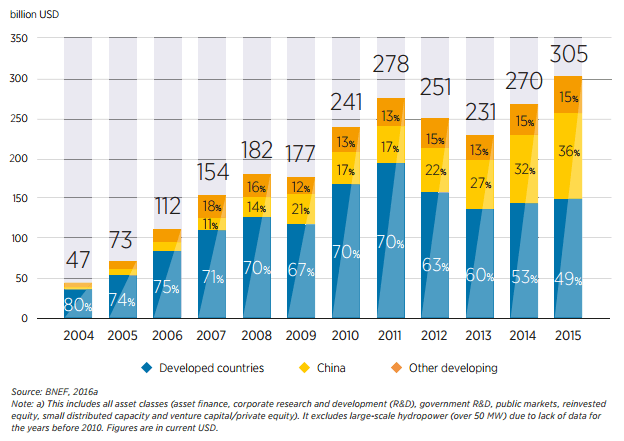
7. Green Bonds Record
In 2016, more than $62 billion in green bonds were issued in the first 10 months alone, making this a record year. In 2015, nearly half of the $41.8 billion green bond-labelled proceeds went to renewable energy projects according to IRENA. Renewables represent the biggest sector in the green bond universe according to the report. Interest in green bonds is growing rapidly, particularly in emerging markets led by India and China. Green bonds are also a key form of funding in the sustainable infrastructure sector. Climate-KIC, the EU’s climate innovation initiative, is helping Mexico with its first green bond at the municipal level.
Growth, 2008-2016
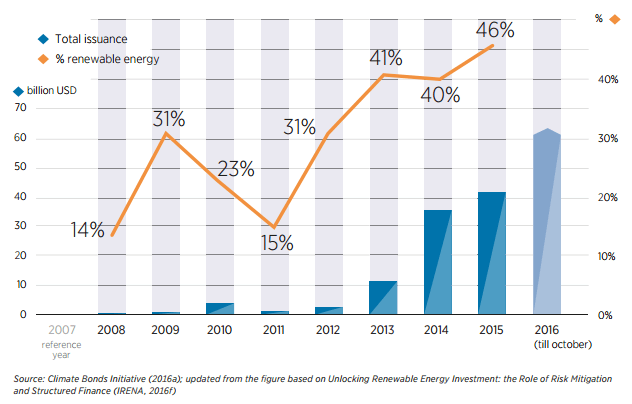
Next Steps
IRENA chief Adnan Z. Amin said the world should now focus on expanding the energy transition’s scope beyond the power sector. He says this will “not only reduce carbon emissions, it will improve lives, create jobs, achieve development goals, and ensure a cleaner and more prosperous future.”
If we’re able to double renewables by 2030, our world can remain within a safe carbon emission framework—Adnan Z. Amin, DG @IRENA #IRENA7A pic.twitter.com/r7YeOBgLeE
— IRENA (@IRENA) January 15, 2017
Read the full report to find out how IRENA thinks policy, investment and innovation could further accelerate the renewable energy revolution.
Discover how Climate-KIC programmes like Low Carbon City Lab and Building Technologies Accelerator are accelerating the decarbonisation of cities and buildings.

